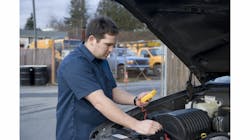Just like any other replacement part, batteries wear out. However, because weak batteries aren't as noticeable as balding tires or squeaky brakes, they are usually replaced only after they fail.
With proper care and maintenance, an initial investment in deep-cycle flooded, AGM (Absorption Glass Mat) or gel battery technology can be extended, keeping the total cost of ownership to a minimum. Following some simple steps will ensure that truck batteries will enable optimum equipment operation levels day in and day out.
1) Safety
- Always wear protective clothing, safety glasses and gloves.
- Always use insulated tools.
- Never add acid to a battery.
- Keep batteries clean and dry.
- Charge batteries only in well ventilated areas.
- Avoid skin contact with electrolyte.
2) Watering (flooded batteries only)
- Add water only after fully charging the battery (unless the plates are exposed).
- Check with the manufacturer regarding proper electrolyte fill levels.
- Never allow the electrolyte level to fall below the plates.
- Use distilled water.
3) Charging
- Follow the manufacturer's charging instructions.
- Add water to flooded batteries after they are charged, not before.
- Do not interrupt a charge cycle, unless opportunity charging (battery charging when the opportunity presents itself rather than waiting until the battery reaches a specific discharge level).
- Never charge a frozen battery.
- Avoid charging at temperatures above 120 degrees F (49 degrees C).
4) Cleaning
- Clean the battery terminals and cable lugs regularly with a solution of one cup of baking soda and one gallon of water using a wire brush. Rinse with water and dry.
- Thinly coat all connections with anti-corrosion spray or silicone gel to resist corrosion.
5) Torque
- Tighten all wiring connections per the battery manufacturer's specifications.
- Be careful not to over tighten as this can result in post breakage.
- Avoid under tightening which can result in post meltdown.
- Make sure there is good contact with the terminals.
6) Storing
When storing batteries for an extended period of time:
- Completely charge batteries before storing and monitor every six weeks while in storage.
- Batteries gradually self discharge during storage. AGM batteries self discharge at a much slower rate than flooded batteries. Be sure to monitor voltage every four to six weeks.
- Stored batteries should be given a boost charge when they are at 70 percent state of charge or less.
- Store batteries in a cool, dry location, avoiding areas where freezing temperatures are expected.
- Keep batteries fully charged to prevent freezing.
- When batteries are taken out of storage, recharge them before use.
- Avoid direct exposure to heat sources, such as radiators or heaters.





